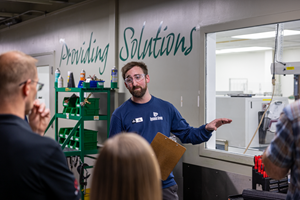Uncertainty in Automotive Market for 2019
It’s not clear yet how trade tensions and interest rates will affect stagnant vehicle sales.
If trade tensions escalate and interest rates increase throughout 2019, the automotive industry may find it harder than expected to expand. During 2018, the auto industry tracked along the same trajectory as the prior year. Unit sales data for 2018 showed growing preference for SUVs and light trucks over cars. This trend is not new: unit car sales peaked in June 2014 and have seen an average 7.5% annualized contraction in the 17 quarters since then. Truck and SUV sales continue to offset the weakness in car sales, keeping total vehicle sales since mid-2015 at a monthly average of 1.4 million units, or 17.3 million on an annual basis. Looking forward to 2019, there are several factors such as interest rates and tariffs that will have significant near-term effects on the automotive market.
This year is the third year that interest rates have increased, raising the cost of all loans. The latest data for 2018 indicates that the current vehicle interest rate of 6.16% is 10% higher than a year ago and over 22% higher than two years ago, when the average rate was just over 5%. Initially, these rate increases, which increase monthly finance payments, did not slow the growth in average financing amount, which peaked at over $30,500 during the first quarter of 2018. The latest data available in October showed the average amount financed has now fallen over 2%, or over $600 per vehicle.
Furthermore, recent tariff data indicates that new U.S. trade laws enacted during 2018 have produced asymmetrical effects that have hurt U.S. exports more than they have helped domestic sales. Seasonally adjusted figures from the Bureau of Economic Analysis indicate Canadian and Mexican imports of U.S. automobiles have declined 20% from a year ago. One would have to go back to 2011 to find such low levels of Canadian and Mexican imports of U.S. vehicles. The value of U.S. automotive manufacturing shipments in general between April and the latest available data from September indicates a 10% decline.
Although many of the latest trade regulations have had relatively little time to make their impact felt, the underwhelming change in U.S. import consumption is evident in automotive. The ratio of domestic to imported cars and trucks sold in the U.S. during the second half of 2018 indicated no shift in this ratio through October. The market share of imported vehicles sold in the U.S. during the second half of 2018 has yet to indicate a significant change.
The sheer number of factors impacting the automotive market make it difficult to predict the path of the automotive industry in 2019. If trade tensions escalate and interest rates increase throughout 2019, the automotive industry may find it harder than expected to expand.
ABOUT THE AUTHOR: Michael Guckes is the chief economist for Gardner Business Intelligence, a division of Gardner Business Media, Cincinnati. He has performed economic analysis, modeling and forecasting work for nearly 20 years among a wide range of industries. Guckes received his BA in political science and economics from Kenyon College and his MBA from The Ohio State University. mguckes@gardnerweb.com.
Related Content
Medical Molder, Moldmaker Embraces Continuous Improvement
True to the adjective in its name, Dynamic Group has been characterized by constant change, activity and progress over its nearly five decades as a medical molder and moldmaker.
Read MoreHow to Extrusion Blow Mold PHA/PLA Blends
You need to pay attention to the inherent characteristics of biopolymers PHA/PLA materials when setting process parameters to realize better and more consistent outcomes.
Read MoreGet Color Changes Right In Extrusion Blow Molding
Follow these best practices to minimize loss of time, material and labor during color changes in molding containers from bottles to jerrycans. The authors explore what this means for each step of the process, from raw-material infeed to handling and reprocessing tails and trim.
Read MorePHA Compound Molded into “World’s First” Biodegradable Bottle Closures
Beyond Plastic and partners have created a certified biodegradable PHA compound that can be injection molded into 38-mm closures in a sub 6-second cycle from a multicavity hot runner tool.
Read MoreRead Next
Beyond Prototypes: 8 Ways the Plastics Industry Is Using 3D Printing
Plastics processors are finding applications for 3D printing around the plant and across the supply chain. Here are 8 examples to look for at NPE2024.
Read MoreFor PLASTICS' CEO Seaholm, NPE to Shine Light on Sustainability Successes
With advocacy, communication and sustainability as three main pillars, Seaholm leads a trade association to NPE that ‘is more active today than we have ever been.’
Read More
.jpg;width=70;height=70;mode=crop)




















